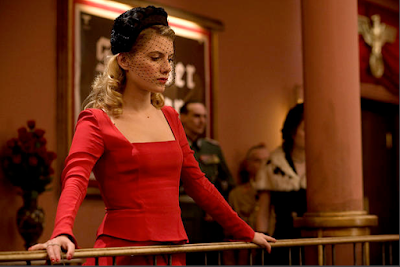Catching up on last week: I've been slowly delving back into my vast VHS archive and transferring it to DVD. Two of this weeks viewings were watched during this process.
Ringo Lam's Burning Paradise (1994) was a huge failure when it was originally released, but it's an interesting failure none the less. Ostensibly a kung-fu movie set in the aftermath of the burning of the Shaolin temple, this is really a horror movie in disguise. Most of the action is set in the Red Lotus Temple, which has been turned into a prison by the ruling Manchus and is ruled by the monstrous Elder Kung. The hero of the film is that ubiquitous wu xia hero, Fong Sai Yuk, who is incarcerated with the rest of his fellow monks. The temple is a house of horrors, in which the monks are toyed with by the jailers with a myriad selection of ghastly traps, the most baroque of which is a statue of the Buddha rigged to mow down the supplicants who give offerings, but there's also an appearance of that famous tool of mayhem, the flying guillotine. This is a Tsui-Hark production and it has the look of some of Hark's other movies, but the director imports his own, gritty sensibility to the violence. It may look a bit like Once Upon a Time in China, but at its heart, this is a redux of Prison on Fire. I quite like it.
You have to squint to see the familial resemblance between La pointe-courte (1954), Agnes Varda's first film, and the other lions of the New Wave, but it's there. Varda wasn't a cineaste, like the Cahiers crowd. She was a photographer. The difference in approach shows through; this isn't a reflexive film, but is rather a very carefully controlled one. It is very different from the chaos (or freedom, if you prefer) of Godard or Truffaut. But the similarity is there in the way Varda uses found images. The instance that jumps out at me is the sudden squeal of a slowly moving train. It's inserted for texture, just for the hell of it, because the director CAN insert it, and that's the soul of the New Wave. Which is all well and good, but this film also seems like one of those films at the nexus of all cinematic realities. The background story, about a fishing village that's fishing in polluted waters, is reminiscent of Visconti, while the central character arc seems positively Bergmanesque (including a shot that anticipates a very famous one in Persona, a decade before the fact). It's like this one film, placed at a very precarious point in time, is some weird kind of singularity sucking up all of the European cinema around it.
It's a lot of fun watching Ruth Chatterton walking with a swagger that would be the envy of most men in Female (1933, directed in turns by William Dieterle, William Wellman, and Michael Curtiz). A hard as nails automotive CEO, she has little time for “feminine” niceties. When she sees a man she wants, she takes him. All well and good, but this one goes all weak in the knees in the end as our heroine meets a man who makes her want to be more “feminine,” which is disappointing, and a little reprehensible given the way it puts her business in the lurch. But cultural norms will out, I guess. It's still fun for most of its running time. Even so, Chatterton's profligate career was completely unacceptable to the Breen office, and rather than castrate the film on re-release, it was simply banned. Alas.





















